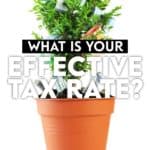What is Your Effective Tax Rate?

One of the sources of confusion for many Canadians is the way that taxes are described. We hear about tax brackets and tax rates, but it can be difficult to conceive of how much of our income is actually taxed.
If you want a better idea of how much you are actually paying in taxes, as expressed as a percentage of your income, it makes sense to consider your effective tax rate, rather than your marginal tax rate.
Marginal Tax Rate vs. Effective Tax Rate
Your marginal tax rate is what you see when you consider what tax bracket you are in. Realize, though, that your marginal tax rate doesn’t indicate how much your are taxed on your entire income. Instead, your tax bracket shows how much you are taxed on your last dollar.
If you are in the 30.5% tax bracket, your entire income is not taxed at 30.5%. Only the amount of income you have exceeding the level of the next bracket below your marginal rate is taxed at 30.5%. In reality, your income is chunked out at 0%, 15%, 25%, and 30.5%. So you pay tax at all of those rates.
Your effective tax rate is figured much more simply. It’s about averaging your total tax paid. Your effective tax rate indicates how much you pay, on average, on your total income. In order to determine your effective tax rate, you take the total amount you paid in taxes, and divide it by your total income. So, if you pay $5,000 in taxes after all of your tax benefits, and your income is $45,000 a year, your effective tax rate is 11.11%, no matter what your marginal rate is.
What About Other Taxes?
Generally, when you consider only your federal income taxes, you are going to end up with a lower effective tax rate than marginal tax rate; the average of lower taxes paid on income at different bracket levels brings down the average.
However, if you really want to get into your effective tax rate, you can also consider the other taxes you pay. Provincial income tax and even GST paid throughout the year can bring up your effective average. If you want a true idea of your effective tax rate, add up what you pay in all these other taxes as well, and then divide by your income. In the example above, if you realize that you have been paying other taxes throughout the year, and your total income tax plus other taxes in $9,000, your effective tax rate is suddenly 20%.
Your effective tax rate is a better measure of how much of your income is actually going toward paying taxes. For those closer to the top of the income scale, this can actually be somewhat comforting. You might be in the 30.5% tax bracket, but, really, you’re only paying an effective tax rate of 20% when everything is factored in. For those in the lower tax brackets, though, adding in GST and PST (or HST), and other tax costs can actually mean a higher effective rate than marginal rate.
With the help of your effective rate, you can get a more accurate picture of what you pay on average, and use that information to improve your tax planning efforts.


Comments
Without being specific, I can say it is less than my marginal rate.
absolutely on point. I always counsel clients that marginal and average (effective) tax are two very different things.
It is amazing who many Canadians are mislead about the progressive tax system in Canada.
thanks for the understandable article.
Very informative article. Thanks.
I have no quibbles with what you have written, in terms of the definitions used. I would, however, quibble with your emphasis on the ‘effective tax rate’. For tax planning purposes the marginal rate is the concept that tells one how much tax they will pay on (relatively small) income increments. It is this concept that many taxpayers fail to comprehend. For example, if someone is contemplating whether to withdraw money from their RRSP or seek funds elsewhere, it is their marginal tax rate, not the effective tax rate that is of relevance. The additional tax paid as a result of the RRSP withdrawal will be determined using the marginal tax rate. I have had acquaintances who have made very poor decisions based on using their average tax rate to do such calculations. As well, the effective tax rate is an ex post tool: you won’t really know what it might be in a particular year until all your purchases have been made and income earned. The impact of possible incremental decisions on your income position will not be reflected in the effective tax rate. It will show you your overall tax position, but I really don’t see how the effective tax rate could be as useful as the marginal income tax rate as a tax planning tool.
Right but you somehow are equating your net income to your net paycheck.